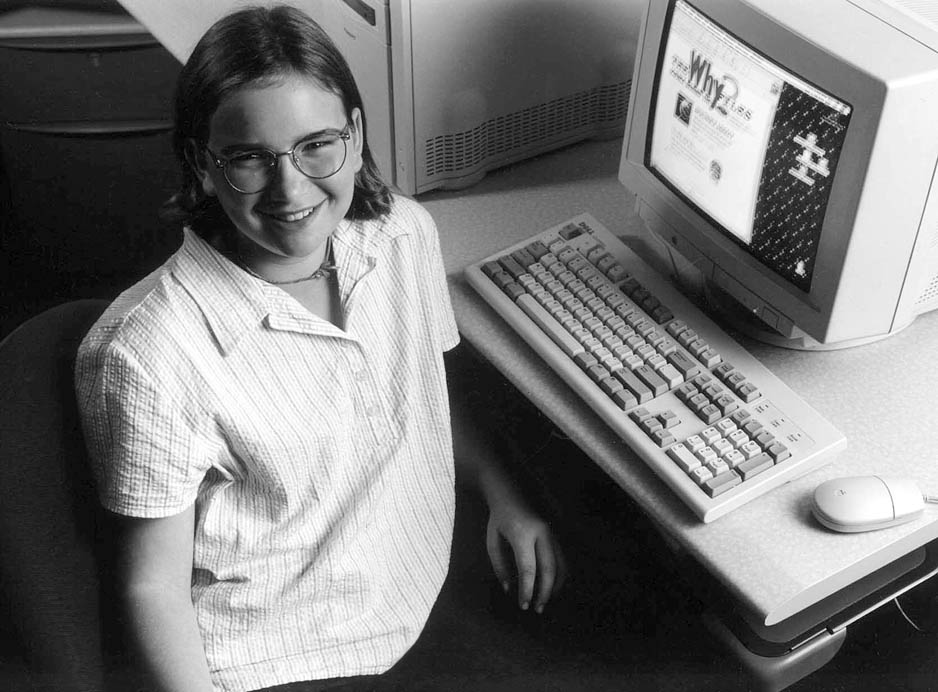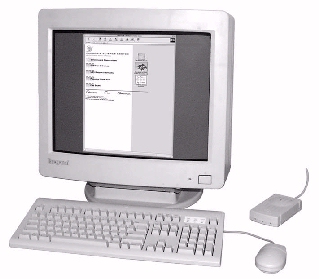 |
 |
The answer in each case lies in the Creative Technology Center (CTC), a new high-tech instructional area at Carnegie Science Center. Located on the building's third floor, the CTC is open to people of all technological skill levels who want-or need-to know more.
"Our goal is to show the public that technology is a powerful tool, and the first step in becoming comfortable with technology is to understand how it can meet your needs," says Maggie Henry, CTC coordinator. Making that point with educators in particular is important to Henry, who notes that teachers as a group have not yet embraced technology to the extent that children have. In the friendly, non-threatening environment of the CTC, teachers can come in and see successful applications of technology for use in their classrooms.
"There are lots of new tools that teachers can use to strengthen instruction in their classes," Henry points out, such as slides, graphs, charts and other graphic images.
"The goal is not only to have teachers teach with these materials, but to have them help students incorporate the information into multimedia presentations," Henry notes. The final result could be self-contained on a disk that the student hands in to the teacher, or it could be published on the World Wide Web and thus be available globally. "Having their project available to such a wide audience would have a great effect on a student's desire to have that project be as effective as possible. It will help to create ownership, which ultimately promotes learning."
Using technological tools such as graphs, charts and spreadsheets could enhance a lesson on, say, nutrition. In such a project, the students would keep track of foods eaten during the course of a week, incorporate the information into a spreadsheet, then create graphs and charts based on the collected data. Afterward, they could compare their results with the standard food pyramid and identify deficiencies in their diets. Working with various charts and graphs will help students determine which kinds of visuals are most useful for conveying various kinds of information. As an added bonus, students would be practicing math and science in addition to learning about the subject at hand-nutrition in this case.
The public is invited to use the CTC as well. Science Center visitors are invited to stop in and use the computers, and classes are available for individuals who want a more in-depth exploration of multimedia technology, the Internet or educational software, or who simply want to improve their knowledge and skills.
Perhaps someone has an important presentation to make at a meeting and wants to impress the boss. A class at the CTC will show her how to create materials that will wow her audience. Or perhaps someone needs to decide what kind of software to buy for keeping track of personal finances. Exploring the options at the CTC is a smart, pressure-free way to find an answer.
"Many senior citizens are finding that e-mail is an ideal way to correspond with their college-age grandchildren," Henry says, so special seniors-only classes are planned for Tuesdays, when the Science Center offers $2 admission to senior citizens.
While Henry expects the general public to be heavy users of the CTC, she is certain that teachers will find it invaluable. The need for a facility like the CTC was identified in a study done by the Regional Math/Science Collaborative, a 350-member group representing 111 school districts in nine counties in southwestern Pennsylvania. "The study revealed that teachers wanted a place to go and learn about technology," Henry says, "and now they have it!"
People usually progress through three stages on their way to integrating technology into their lives: comfort, confidence and creativity. The CTC wants its visitors to experience them all. But making teachers comfortable with technology is a goal that cannot be realized in one visit, and so the CTC is prepared to give ongoing guidance.
"We're forming partnerships with schools for long-term support of their technological resources," Henry says. "Some schools have funds to buy equipment, and we can help them understand what they need and empower them to make the right choices based on the curriculum." There will also be professional development opportunities that strengthen classroom instruction by integrating technology and telecommunications into the daily curriculum. Teachers will also be introduced to software that can help them with administrative tasks like gradekeeping or corresponding with parents.
Differences in hardware pose no problem. With 35 dual-platform computers, the CTC is equipped to help users whether they have MacIntosh or personal computers.
The Creative Technology Center furthers the Carnegie Science Center mission of providing public access to information on advances in science and technology. Says Henry, "We're just trying to meet people where their interests and needs are, and to take them beyond that."
It began in 1979, when Henry took a break from nursing to start raising a family. In making clothes for her first child, she became interested in smocking, a type of embroidery, and joined a local guild.
 "I read newsletters
that other guilds were doing, and one in particular stood out. I called
one of the guildmembers to ask some questions about it and was told that
they did the newsletter themselves using desktop publishing," she says.
A newspaper and yearbook editor in high school, Henry was interested in
journalism and was anxious to give her guild newsletter a makeover on the
order of the one she had seen. Problem was, she had no computer. But the
husbands of some of her fellow smockers had them.
"I read newsletters
that other guilds were doing, and one in particular stood out. I called
one of the guildmembers to ask some questions about it and was told that
they did the newsletter themselves using desktop publishing," she says.
A newspaper and yearbook editor in high school, Henry was interested in
journalism and was anxious to give her guild newsletter a makeover on the
order of the one she had seen. Problem was, she had no computer. But the
husbands of some of her fellow smockers had them.
"I went out and bought the software and decided to install it in my neighbor's computer. Neither of us knew what we were doing, and her husband was worried that we'd break the computer. But we followed the manual and managed to install it."
Monthly for a year and a half Henry dutifully trekked to her neighbor's house, children in tow (three by now), and produced her guild newsletter. Eventually the commuting became too much, especially with another baby, so Henry took a deep breath and bought her own computer.
"It sat in its box in my living room for two days while my family got used to the idea," she recalls, laughing. "Then I realized that nobody was going to set it up for me, so I took the computer out of the box, identified the cables and hooked it up." She upgraded her desktop publishing software and happily continued the ever-better newsletter. Then a year or so later, another friend bought a new computer, and this one had a modem in it.
"She came over to my house waving a handful of printouts that were posts to an online sewing bulletin board where the women were discussing the type of sewing that we do," Henry says. "I read these things and thought, wow, I'd really like to talk to these women." But her computer had no modem, making it impossible for her to communicate online. So out she went in search of a modem for her computer.
"I was clueless," she admits. "I didn't even know what 'modem' stood for." After two months of trying to install the modem, Henry was communicating with fellow smockers all across the country.
Then the group's online service increased its monthly fee, prompting a decision to change services. Henry found a cheaper one and brought 110 friends along with her.
"Because I brought all these people along, the company put me in charge of all of the smockers and what they did on the network, sent me a manual on how to work the system and called me a 'sys op' [system operator]," she laughs. Thus she gained her first job in the computer field, and soon she made a decision to return to school to study technology.
A degree in elementary education from Westminster College followed in 1994, after which Henry got a job teaching computer science in an elementary school in Canfield, Ohio. Two years later she enrolled at the University of Pittsburgh in a program to obtain a certificate in Instructional Design and Technology. While at Pitt, Henry taught computer skills to students planning to become teachers.
"Then I saw an ad in the newspaper that said: Carnegie Science Center, 3-5 years teaching experience, strong technology background," Henry recalls. "Knowing nothing more about it, I said to myself, 'This job has my name on it,' and the rest is history." Henry has been at the Science Center since June 1997, coordinating the newly opened Creative Technology Center, where she hopes to share her knowledge with teachers and members of the public. Seemingly still a little surprised at herself, Henry is an example of what one can accomplish with persistence and a can-do attitude.
Kathryn M. Duda is associate editor of Carnegie Magazine.
For information about classes at the Creative Technology Center, call 237-3410.
Contents |
Highlights |
Calendar |
Back Issues |
Museums |